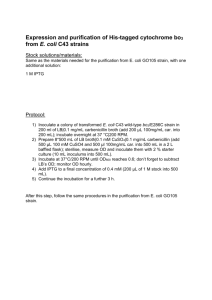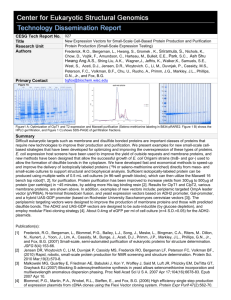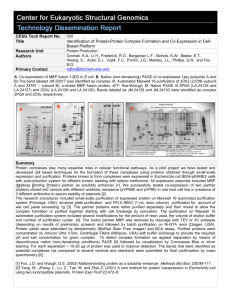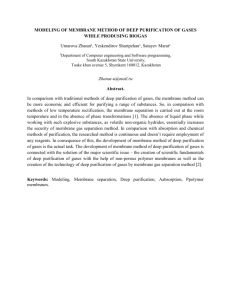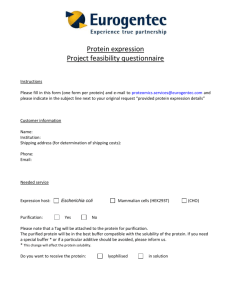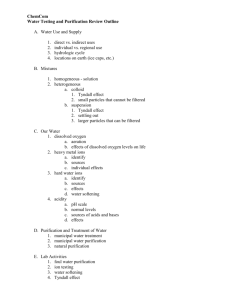Center for Eukaryotic Structural Genomics (CESG)
advertisement
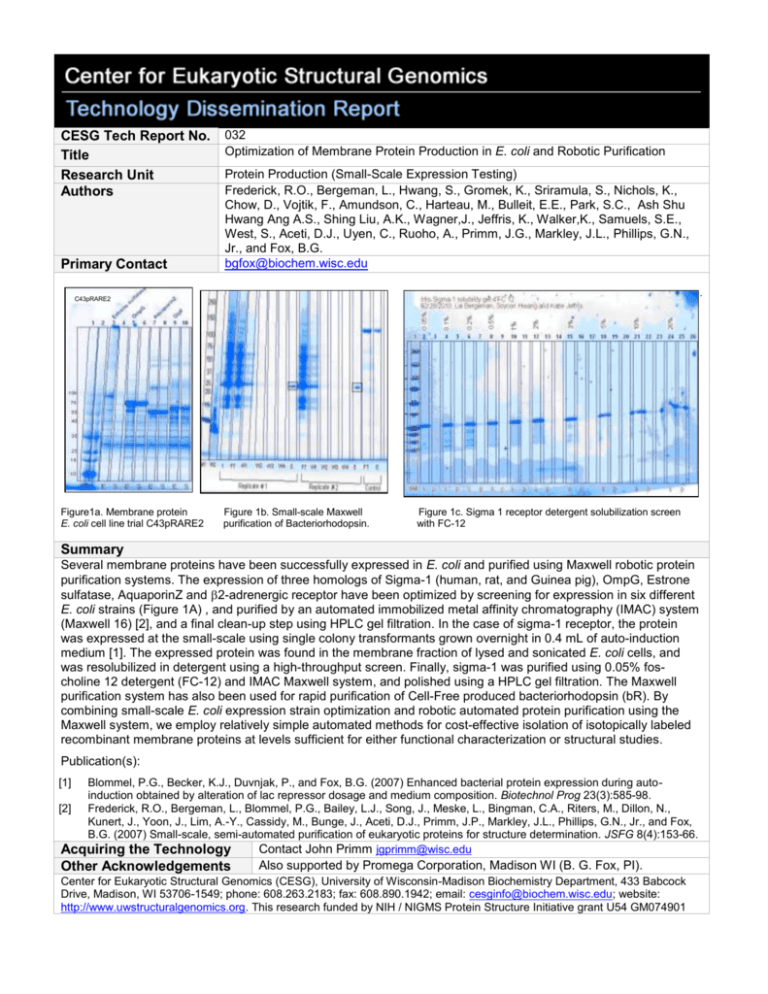
CESG Tech Report No. Title Research Unit Authors Primary Contact 032 Optimization of Membrane Protein Production in E. coli and Robotic Purification Protein Production (Small-Scale Expression Testing) Frederick, R.O., Bergeman, L., Hwang, S., Gromek, K., Sriramula, S., Nichols, K., Chow, D., Vojtik, F., Amundson, C., Harteau, M., Bulleit, E.E., Park, S.C., Ash Shu Hwang Ang A.S., Shing Liu, A.K., Wagner,J., Jeffris, K., Walker,K., Samuels, S.E., West, S., Aceti, D.J., Uyen, C., Ruoho, A., Primm, J.G., Markley, J.L., Phillips, G.N., Jr., and Fox, B.G. bgfox@biochem.wisc.edu . C43pRARE2 Figure1a. Membrane protein E. coli cell line trial C43pRARE2 Figure 1b. Small-scale Maxwell purification of Bacteriorhodopsin. Figure 1c. Sigma 1 receptor detergent solubilization screen with FC-12 Summary Several membrane proteins have been successfully expressed in E. coli and purified using Maxwell robotic protein purification systems. The expression of three homologs of Sigma-1 (human, rat, and Guinea pig), OmpG, Estrone sulfatase, AquaporinZ and 2-adrenergic receptor have been optimized by screening for expression in six different E. coli strains (Figure 1A) , and purified by an automated immobilized metal affinity chromatography (IMAC) system (Maxwell 16) [2], and a final clean-up step using HPLC gel filtration. In the case of sigma-1 receptor, the protein was expressed at the small-scale using single colony transformants grown overnight in 0.4 mL of auto-induction medium [1]. The expressed protein was found in the membrane fraction of lysed and sonicated E. coli cells, and was resolubilized in detergent using a high-throughput screen. Finally, sigma-1 was purified using 0.05% foscholine 12 detergent (FC-12) and IMAC Maxwell system, and polished using a HPLC gel filtration. The Maxwell purification system has also been used for rapid purification of Cell-Free produced bacteriorhodopsin (bR). By combining small-scale E. coli expression strain optimization and robotic automated protein purification using the Maxwell system, we employ relatively simple automated methods for cost-effective isolation of isotopically labeled recombinant membrane proteins at levels sufficient for either functional characterization or structural studies. Publication(s): [1] Blommel, P.G., Becker, K.J., Duvnjak, P., and Fox, B.G. (2007) Enhanced bacterial protein expression during autoinduction obtained by alteration of lac repressor dosage and medium composition. Biotechnol Prog 23(3):585-98. [2] Frederick, R.O., Bergeman, L., Blommel, P.G., Bailey, L.J., Song, J., Meske, L., Bingman, C.A., Riters, M., Dillon, N., Kunert, J., Yoon, J., Lim, A.-Y., Cassidy, M., Bunge, J., Aceti, D.J., Primm, J.P., Markley, J.L., Phillips, G.N., Jr., and Fox, B.G. (2007) Small-scale, semi-automated purification of eukaryotic proteins for structure determination. JSFG 8(4):153-66. Contact John Primm jgprimm@wisc.edu Acquiring the Technology Other Acknowledgements Also supported by Promega Corporation, Madison WI (B. G. Fox, PI). Center for Eukaryotic Structural Genomics (CESG), University of Wisconsin-Madison Biochemistry Department, 433 Babcock Drive, Madison, WI 53706-1549; phone: 608.263.2183; fax: 608.890.1942; email: cesginfo@biochem.wisc.edu; website: http://www.uwstructuralgenomics.org. This research funded by NIH / NIGMS Protein Structure Initiative grant U54 GM074901

